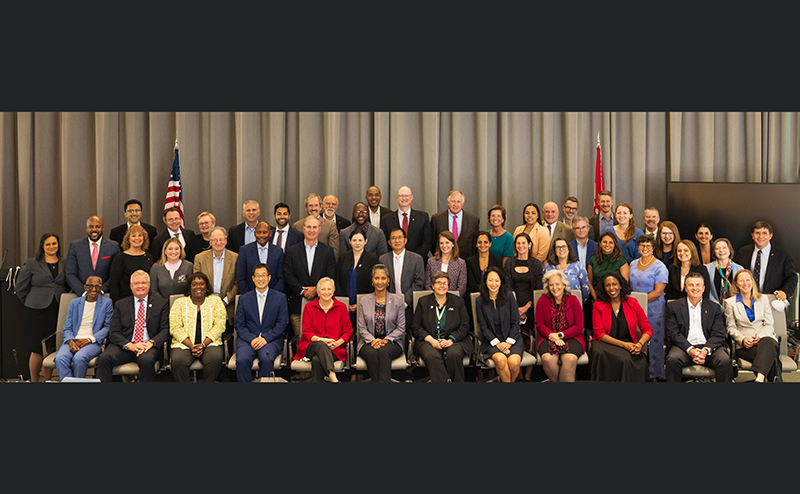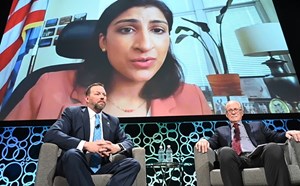Major medical organizations form a coalition to stem the rising tide of firearm violence using a comprehensive public health approach grounded in community-centered prevention programs; engagement and education of healthcare professionals; and advocacy for data-driven policy initiatives.
The increase in firearm-related violence since the COVID-19 pandemic requires urgent and comprehensive action to address the problem.
Key Takeaways
- A new coalition to address firearm violence: A new group — the Healthcare Coalition for Firearm Injury Prevention — is being established to advance firearm injury prevention using a public health approach.
- Violence prevention starts in the community: Community engagement programs at the local level have been effective in preventing repeat offenders and improving attitudes toward reducing violence.
- Firearm owners must be part of the solution: Engaging firearm owners as part of the solution allows for broad-level engagement from everyone dedicated to reducing firearm injury and is critical to the implementation of firearm safety initiatives.
Leading medical and public health professional organizations across the United States are coming together to form the Healthcare Coalition for Firearm Injury Prevention to push for a comprehensive public health approach to advance firearm injury prevention efforts through education, advocacy, and community-centered approaches to address this growing problem.
Representatives from 46 organizations convened for the second Medical Summit on Firearm Injury Prevention in September 2022, one of the largest gatherings of medical and injury prevention professionals on this issue. This Summit featured a review of community violence initiatives, strategies to support healthcare-centered communication, and a review of the evidence informing public policy for firearm injury prevention. The objectives of the Summit focused on identifying consensus-based, non-partisan strategies that can be effective in reducing the burden of firearm injury in communities across the United States. The proceedings from the Summit are published today in the Journal of the American College of Surgeons (JACS).
Healthcare professionals see the impact of firearm violence in their communities every day. This perspective, and the direct contact they have to those at risk of firearm violence, allow medical professionals to propose real, workable solutions to reduce firearm-related injury, death, and disability.
The scope of the problem
The inaugural Medical Summit on Firearm Injury Prevention took place in 2019. Since then, levels of violence have continued to increase in the U.S.—firearm-related deaths increased 28.4% during the first year of the COVID-19 pandemic and non-fatal firearm injuries increased 34.2% during the same period.1 Further, firearm-related injury has now eclipsed motor vehicle fatalities as the leading cause of death in the U.S. for children and adolescents, age 1-19 years.2
To renew efforts to address this ongoing public health crisis, leaders of the American College of Surgeons (ACS), American College of Physicians (ACP), American College of Emergency Physicians (ACEP), American Academy of Pediatrics (AAP), and the Council of Medical Specialty Societies (CMSS) cohosted the second Medical Summit on Firearm Injury Prevention. Forty-six organizations attended the Summit, during which sessions were held on public policy initiatives, addressing community violence, and effective healthcare-centered communication on firearm injury prevention.
Community-level firearm injury prevention efforts
“All clinicians who care for patients have the opportunity to identify those at risk of firearm injury and provide counseling to mitigate these risks,” the authors wrote in the article. They provided specific examples of what these clinical opportunities include:
- Education on secure firearm storage
- Lethal means safety counseling, where healthcare providers work with patients who are at-risk of injury or death and their families to reduce access to firearms
- Family support in the implementation of extreme risk protection programs (to temporarily remove firearms from the homes of those at risk for suicide or domestic violence)
- Hospital and community-centered violence intervention programs
- Mentoring programs for at risk youth
- Integration of social care into the delivery of health care
These community engagement programs are rooted in the understanding of social determinants of health and the principles of Trauma Informed Care, which is an approach that addresses implicit bias and creates an environment for patients that promotes equity, sensitivity of broader needs, and empowerment.
Engaging firearm owners as part of the solution
Summit attendees noted the importance of broad community engagement to address firearm violence, which requires engagement from everyone dedicated to reducing firearm injury.
“All too often the community of firearm owners in the U.S. are approached as part of the firearm injury problem, and less commonly as part of the solution,” the authors wrote.
An example of this engagement is a strategy pursued by the ACS Committee on Trauma (COT) that acknowledges both the constitutional right to keep and bear arms and the critical and significant problem of intentional firearm violence in the U.S. The ACS has established a Firearm Strategy Team (FAST) of firearm owning surgeons to inform and advise on firearm safety initiatives.
The authors also noted that there have been successful partnerships between health professionals and firearm retailers, instructors, and advocates. Firearm owners and experts are seen as “trusted messengers” and have effectively delivered firearm safety messages in their communities.
Summit attendees called for further engagement with firearm owners through the new Healthcare Coalition for Firearm Injury Prevention.
A consensus-based, comprehensive public health approach
Just as motor vehicle deaths have sharply declined over the years due to public health-based injury prevention strategies, a comprehensive public health and medical approach is necessary to reduce firearm injury, death, and disability.
To achieve the goals outlined at the Summit, the sponsoring organizations agreed to establish the Healthcare Coalition for Firearm Injury Prevention. This Coalition will include the following workgroups: Health Professional Education, Advocacy and Policy Initiatives, Healthcare Professional Engagement for Firearm Safety, Communications, and Community-Centered Approach for Violence Prevention.
“Establishing this coalition provides a venue to continue ongoing multidisciplinary collaboration and leverage the resources of the entire public health and healthcare community,” the authors concluded. “The opportunity is before us, and the time is now to address this critically important American public health problem.”
The following comments were issued by article authors and leaders from the five organizations that co-hosted the Summit:
“Preventing firearm violence requires a multifaceted approach, one that includes not only common-sense firearm legislation, but also addressing the underlying social and economic factors that contribute to it,” said Joseph V. Sakran, MD, MPH, MPA, FACS, survivor and trauma surgeon at Johns Hopkins Medicine. “We have come together as a medical community to create a society where every person feels safe and valued, and where the senseless loss of life due to firearm violence becomes a thing of the past.”
“Effective healthcare is not just about treating the wounds of firearm violence, but also preventing them in the first place. By addressing the root causes of violence and providing education and support, healthcare professionals can play a crucial role in preventing firearm violence and promoting a safer, healthier society,” said Eileen M. Bulger, MD, FACS, Medical Director, ACS Trauma Programs. “This renewed effort to create a Healthcare Coalition for Firearm Injury Prevention leverages the talents of major medical organizations across America as we guide the nation in tackling this public health crisis.”
“The crisis of firearm violence continues to afflict communities across this country, day after day. The American College of Surgeons and our coalition partners have come together because the medical community is well positioned to help address this vexing issue,” said Patricia L. Turner, MD, MBA, FACS, ACS Executive Director & CEO. “By taking an approach that we know works for other public health issues, and by engaging all stakeholders, including those who own firearms, we can create actionable solutions to reduce death and save lives.”
“Firearms-related deaths and injuries are a public health crisis that need immediate action. We need to employ commonsense strategies that will help to keep our patients and our communities safe. For nearly 30 years, the American College of Physicians has called attention to this issue and believes that as trusted resources for our patients, physicians should be part of informing our patients about what they can do to keep themselves and their families safer,” said Sue S. Bornstein, MD, MACP, chair, ACP Board of Regents.
“Firearm violence indelibly affects emergency department patients and their families as well as those of us who care for them,” said Christopher S. Kang, MD, FACEP, president of ACEP. “Efforts to curb firearm violence and promote safety and injury prevention are a public health imperative. Emergency physicians are a vital partner in these collaborative efforts by the healthcare community to improve treatments, save lives, and prevent more tragedies from occurring.”
“As firearms are now the leading cause of death for U.S. children and youth, the American Academy of Pediatrics was proud to be one of the organizing members of the Medical Summit on Firearm Injury Prevention,” said Lois K. Lee, MD, MPH, FAAP, chair of the AAP Council on Injury, Violence and Poison Prevention. “We understand the lifelong consequences firearm injuries and deaths have to children, their families, and communities, and we must do better for our children. By using a multi-pronged approach, we can start to address this serious public health crisis.”
“The complex topic of firearm injury prevention requires a coordinated and concerted effort on the part of the entire medical community. As an organization of 50 specialty societies, we recognize the enormous potential of working together in this new coalition to prevent firearm injuries,” said Helen Burstin, MD, MPH, chief executive officer of the Council of Medical Specialty Societies. “By jointly addressing key levers that prevent firearm injury, including health professions education, community engagement, and advocacy, we can ensure that our collective efforts will be greater than the sum of individual organizational efforts.”
Article authors are Joseph V. Sakran, MD, MPH, MPA, FACS; Sue S. Bornstein, MD, MACP; Rochelle Dicker, MD, FACS; Frederick P. Rivara, MD, MPH, FAAP; Brendan T. Campbell, MD, MPH, FACS, FAAP; Rebecca M. Cunningham, MD, FACEP; Marian Betz, MD, MPH; Stephen Hargarten, MD, MPH; Ashley Williams, MD, FACS; Joshua M. Horwitz, JD; Deepika Nehra, MD, FACS; Helen Burstin, MD, MPH, MACP; Karen Sheehan, MD, MPH; Fatimah L. Dreier; Thea James, MD, FACEP; Chethan Sathya, MD, MSCE; John H. Armstrong, MD, FACS; Ali Rowhani-Rahbar, MD, MPH, PhD; Scott Charles, MAPP; Amy Goldberg MD, FACS; Lois K. Lee, MD, MPH, FAAP, FACEP; Ronald M. Stewart, MD, FACS; Jeffrey D. Kerby, MD, PhD, FACS; Patricia L. Turner, MD, MBA, FACS; and Eileen M. Bulger, MD, FACS.
The article authors have no relevant disclosures to report.
This article is published as an article in press on the JACS website.
Citation: Sakran JV, Bornstein SS, Dicker R, et al. Proceedings from the Second Medical Summit on Firearm Injury Prevention, 2022: Creating a Sustainable Healthcare Coalition to Advance a Multidisciplinary Public Health Approach. Journal of American College of Surgeons. DOI: 10.1097/XCS.0000000000000662
Further information on ACS firearm injury prevention activities, including resources for journalists, is available on the ACS website.
________________
1Sun S, Cao W, Ge Y, Siegel M, Wellenius GA. Analysis of Firearm Violence During the COVID-19 Pandemic in the US. JAMA Netw Open. 2022 Apr 1;5(4):e229393.
2JE Goldstick, RM Cunningham, P Carter Current Causes of Death in Children and Adolescents in the United States. N Engl J Med, 386 (2022), pp. 1955-1956.
September 15, 2022
In response to the public health crisis of firearm violence, professionals from 47 multidisciplinary medical societies and health organizations from across the country participated in a Medical Summit on Firearm Injury Prevention at the American College of Surgeons (ACS) headquarters in Chicago on Sept. 10-11.
Cohosted by ACEP, ACS, American College of Physicians, American Academy of Pediatrics, and the Council of Medical Specialty Societies, this hybrid in-person and virtual meeting was the second such meeting aimed at developing firearm violence prevention recommendations. It built upon the first Medical Summit’s work from 2019.
The meeting provided an opportunity for an inclusive and collegial dialogue on identifying opportunities for the medical community to reach a consensus-based approach to firearm injury prevention, with a focus on understanding and addressing the root causes of firearm violence while advocating for bipartisan policy solutions to address the issue.
Broadly, topics discussed included:
- The public health approach to firearm violence in the US
- Recent and potential legislative approaches related to prevention
- Addressing violence through community engagement
- Utilizing healthcare resources to influence the social determinants that contribute to violence
- How effective communication on firearm violence from the healthcare sector can influence policy work and community building
Some of the most significant work at the summit came from breakout discussions during each session, where participants worked together to educate one another on their areas of expertise and develop a set of initial recommendations that will drive the coalition’s future action.
The planning committee will compile and disseminate the recommendations and proceedings for participating organizations to consider further. Leaders at the summit also committed to a long-term working relationship (or coalition) and agreed to create an infrastructure for continued longitudinal collaboration so that effective firearm violence prevention education, resources, and policy solutions can be pursued.
Proceedings from the second Medical Summit on Firearm Injury Prevention will be released in the coming months.
Organizations that participated in the summit are below:
AFFIRM at the Aspen Institute
American Academy of Family Physicians
American Academy of Ophthalmology
American Academy of Orthopaedic Surgeons
American Academy of Pediatrics
American Academy of Physical Medicine and Rehabilitation
American Association for the Surgery of Trauma
American Association for Emergency Psychiatry
American Association of Neurological Surgeons/Congress of Neurological Surgeons Section on Pediatric Neurological Surgery
American College of Emergency Physicians
American College of Obstetricians and Gynecologists
American College of Physicians
American College of Preventive Medicine
American College of Surgeons
American Geriatrics Society
American Medical Association
American Medical Women's Association
American Pediatric Surgical Association
American Psychiatric Association
American Society of Anesthesiologists
American Society of Nephrology
American Surgical Association
American Thoracic Society
American Trauma Society
Centers for Disease Control
Coalition for National Trauma Research
Council of Medical Specialty Societies
Eastern Association for the Surgery of Trauma
Emergency Medicine Residents Association
Emergency Nurses Association
Injury Free Coalition for Kids/Scientific Union for the Reduction of Gun Violence at Columbia
National Association of Emergency Medical Technicians
National Association of EMS Physicians
National Medical Association
Orthopaedic Trauma Association
Pediatric Trauma Society
Society for Academic Emergency Medicine
Society for Advancement of Violence and Injury Research
Society of Black Academic Surgeons
Society of Critical Care Medicine
Society of General Internal Medicine
Society of Hospital Medicine
Society of Trauma Nurses
The Association of State and Territorial Health Officials
ThinkFirst National Injury Prevention Foundation
Trauma Center Association of America
Trauma Prevention Coalition





